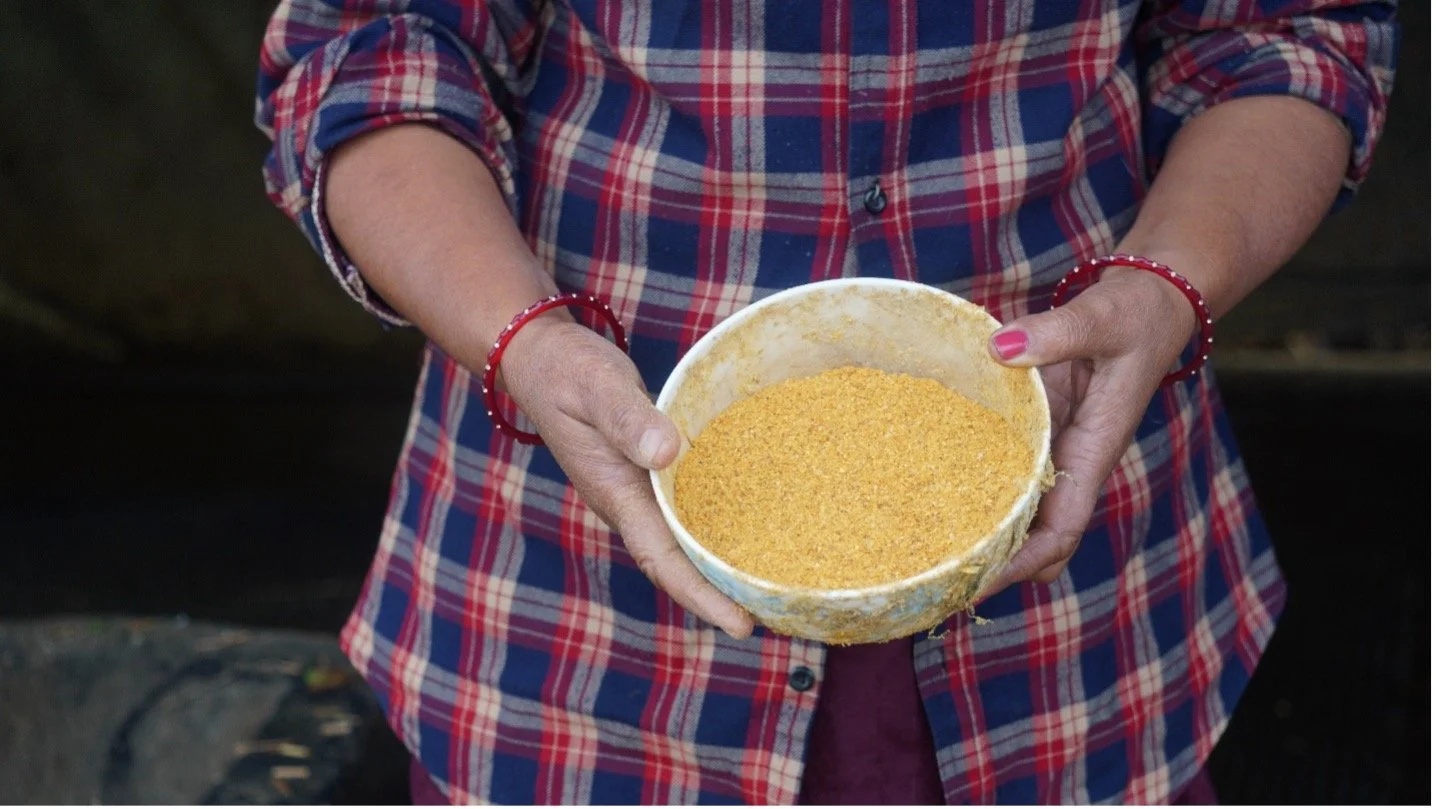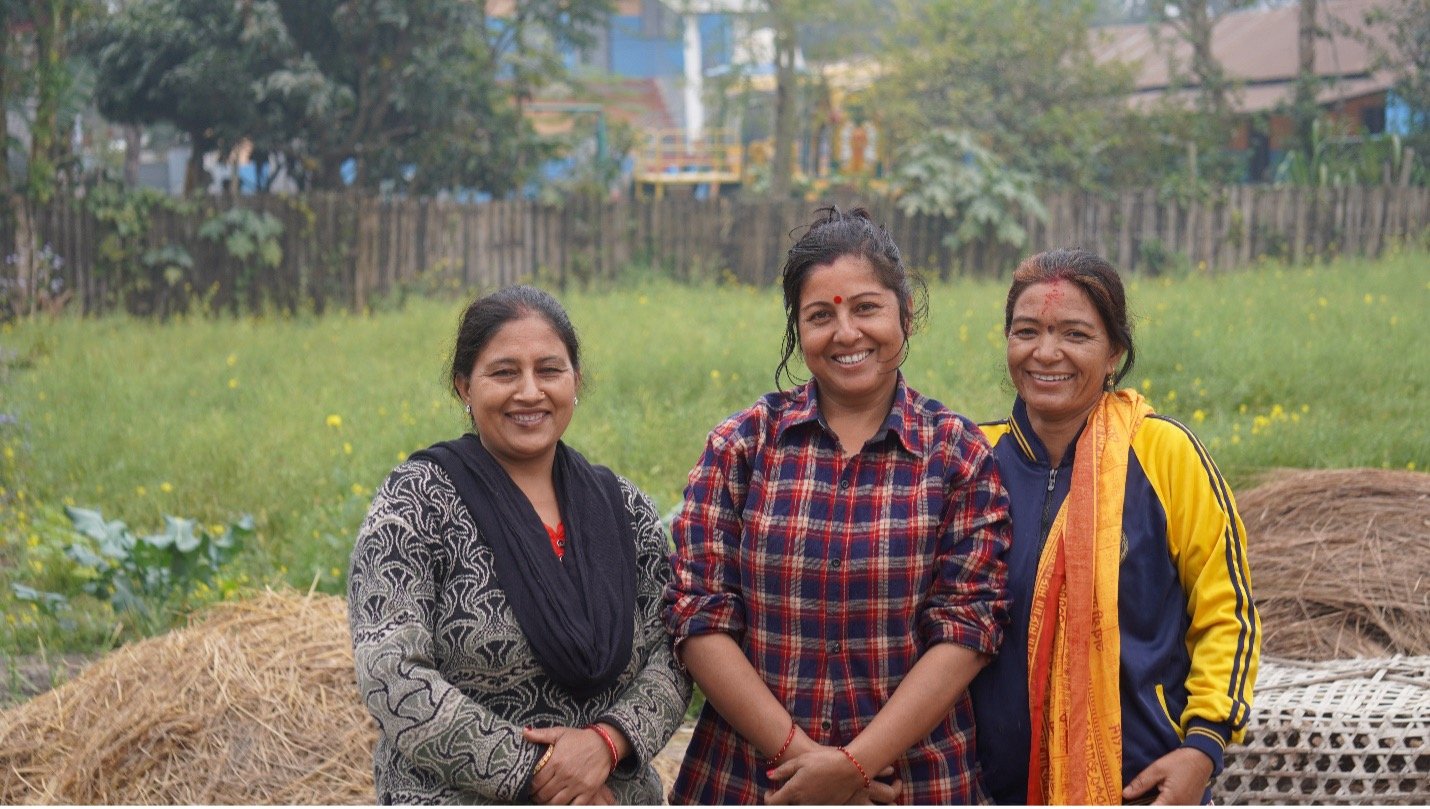Scaling up improved dairy farming: Initial lessons from Sunsari
Farming in Nepal is constrained by limited irrigation, unreliable seeds and inadequate fertilizers. But farmers in the villages of Ramdhuni Municipality of Sunsari district are hindered by an additional limiting factor of human wildlife conflict, with monkeys and other wild animals like blue bulls (Boselaphus sp.) damaging crops. Participatory studies in 2023 under the ACIAR-funded Rupantar project informed that livelihood in these villages can be supplemented by improving cattle rearing practices through increase in yield of quality milk. Further, the national dairy sector analysis points out that the dairy subsector is a key contributor to rural income and holds potential for growth and import substitution in Nepal.[1] Identifying this intervention point, Rupantar is currently promoting scaling activities (capacity building of farmers through cattle management training, exposure visits to improved dairy farms and silage production demonstration) in two villages in the Municipality through a well-established local organization, Sagun Agriculture Cooperative.[2]
Benefits Realized
So far, 50 farmers (half of whom are women) in Kalijhora and Lalpur village have been actively involved in this project. The recent survey revealed that after the intervention more than two-thirds of farmers modified cattle rearing practices. Among those practices, improved feed management is the most practiced, followed by upgraded shed management and proper healthcare/hygiene of their animals. As per our study, push drivers for these changed practices included project-led training, meetings and exposure visits. Pull-factors primarily included sources of income and family nutrition. Almost all farmers who have changed their ways of cattle management have realized higher milk productivity with lowering input costs.
Photo. The hassle-free concentrate feed is saving valuable time for the farmers (PC: Samer Khan)
As accounted by participant farmers first-hand, benefits in synergistic forms have materialized as well. Shifting away from cooked porridge as their livestock’s staple diet has reduced the drudgery of cooking. Furthermore, limiting firewood use reduces smoke that has health as well as ecological merits.
Examples of improved knowledge in cattle rearing principles to marketing milk are also documented. Since the Agriculture Knowledge Center and the Veterinary Hospital and Livestock Service Expert Center (district level agriculture and livestock-related extension offices under the provincial government) have contributed regularly in the field as well, farmers’ awareness and knowledge about government programs and services have also notably improved.
Moreover, farmers themselves have observed more indirect benefits from Sagun’s involvement. Membership in Sagun has supplemented them with saving and credit service. Regular meetings have equipped them with social incentives to keep on with improved practices. Sagun’s ground presence has offered them a warm assurance that this support will continue even after Rupantar’s push ends. Similarly, for Sagun itself avenues for the cooperative’s custom hiring services (rental agriculture machinery) have opened[3].
Challenges and Opportunities
Kumari Mahatara’s expansion of cattle herd from a couple of milking cows to seven has been the major highlight of the first year’s success. Building on this momentum, Rupantar aims to scale improved cattle rearing practices to more households across intervention areas in Sunsari district. However, the first year also brought several challenges. Both input and output side of milk production faced hurdles in scaling improved dairy farming.
Photo: Kumari Mahatara, the over-achieving beneficiary in Lalpur, milking her cow (PC: Samer Khan)
Lumpy Skin Disease outbreaks across Koshi Province also affected the intervention sites[4]. Although the public vaccination program has partially mitigated this, farmers could benefit further from cattle insurance schemes which only a handful of farmers have availed successfully thus far. Most cite irregular visits from the insurance agent as a main reason for low enrollment. Raising awareness and ensuring smoother access could increase participation. Valid claims could also compensate for the heat stress-related cattle mortalities, an emerging challenge of switching to improved (crossbreed of exotic cattle) breeds. But systemic challenges should also be addressed at an institutional level with reports of delayed claim settlements after failing to get government premium subsidies[5].
Repeat breeding has also been a persistent challenge, requiring frequent artificial and natural insemination and increasing both the cost and effort for farmers. Increasing the hassle of finding reliable vets, failed fertilization also burdens them monetarily with repeated insemination service needs. Additionally, it limits the progress of the current cattle line. Improving the current breed toward a more favorable exotic high-yielding phenotype necessitates Artificial Insemination. Nonetheless, repeated failure drives them towards natural means which ensure success at zero monetary cost with free-roaming bulls in and around the village. Planned door-to-door clinics with portable ultrasound facilities collectively by VHLSEC and Agriculture and Forestry University could address much of this issue. Additionally, farmers could benefit from proper knowledge about animal nutrition and the necessity of mineral supplements, a low-hanging solution for repeat breeding[6].
Photo: Each failed insemination means another cost, another visit, another delay. Repeat breeding is a critical concern for dairy farmers. (PC: Samer Khan)
Adoption rate of three out of four farmers, as noted, appears strong for the first year. However, adoption was credited even when only one improved practice (among feeding, shed management, healthcare and hygiene, breed selection, fodder cultivation) was adopted. So, a quarter of farmers have yet to adopt any practice. Their hesitation largely stems from a reluctance to shift towards “modern” methods as opposed to ways they have been following since their memory documents. Therefore, to achieve scaling success, initiatives to increase farmers’ awareness and knowledge of the pros and principles of improved cattle farming is essential.
Silage production turned out to be a success in the initial demonstrations, bridging fooder shortage during the pre-kharif when grass is scarce while also providing additional nutrients missing from regular fodder. However, silage-maker machines are still limited in the region and without adequate availability of such machinery, it would be difficult for expansion. Sagun, whose major business and service (apart from saving and credit) lies in its custom hiring center located reasonably close to the intervention sites could be helped with procuring a silage-maker which would materialize into broader adoption of silage in the region.
Issues on the output side of the milk value chain outweigh the input bottlenecks in the region. This is true for the entire country but more so at the intervention sites where the milk collection center of the local dairy cooperative (the only organized outlet of milk), offers low and delayed payments.
The average price they received over the last year amounted to NPR. 58. For reference, processed and packaged pasteurized milk 5 kilometers south on the highway market is sold for NPR 90-NPR 110 per liter. While 58% is a moderately good producer’s share compared to other agricultural commodities, efficient cooperative based market chain, as evidenced in India, could ensure that up to about 80% of what the consumers pay can go to the farmers. This can be researched further[7].
Delayed payments, sometimes for up to three months, remain a serious concern. Similar issues persist at the national level reflecting both local and national market inefficiencies and rigidities[8]. But some of the problems could be relieved in the intervention sites potentially if farmers could be linked to an alternative accountable and credible collection center as their milk outlet. Plus, processing diversified milk products at a local scale could be a subject of action research as well. A study on consumer behavior regarding milk and milk products could also fruit valuable insights.
Photo: Women in the intervened villages remark that improved dairy farming has provided them “Self-employment” (PC: Samer Khan)
Additional opportunities include registering farmers’ groups formally in the municipality which could improve farmers’ access to services from the livestock section. Initiatives to build the capacity of local para-vets can enhance the quality of the first and nearest solutions to livestock problems. NARC Regional Research Station, the authentic government entity on agriculture and livestock research, could be another collaborator especially considering emerging cattle health issues in the changing environment. CGIAR's Sustainable Animal Productivity for Livelihoods, Nutrition, and Gender Inclusion (SAPLING) initiative undertaken by ILRI in Eastern Nepal can also be explored for potential collaboration[9].
To aim a bit high, if milk production increases considerably in and around the intervention sites, large regional actors like Kamdhenu Dairy Cooperative could be linked with Sagun for more regular and just payments to milk producers.
In the face of several farming constraints, livestock continues to serve as a crucial livelihood alternative for farmers amid existing constraints. Rupantar’s research-for-development initiatives for scaling improved cattle rearing practices can strengthen this pathway. More broadly, dairy is a prized and often championed sector in Koshi province but some initiatives must be taken to untangle the structural supply-and-demand knot to ensure sustainability.
While the cooperative-based model has proven beneficial for both farmers and cooperatives, its sustainable success depends on addressing input bottlenecks and more critically, output side market challenges.
Author
Saurya Karmacharya, Socioeconomic Research Coordinator, CIMMYT
Reference
[1] Shingh, S., Kalwar, C. S., Poudel, S., Tiwari, P., & Jha, S. (2020). A study on growth and performance of dairy sector in Nepal. International Journal of Environment, Agriculture and Biotechnology, 5 (4), 1154-1166. https://doi.org/10.22161/ijeab.54.36
[2] https://www.rupantarfoodsystems.com/non-plot-level-nepal
[3] https://kathmandupost.com/money/2025/10/25/mechanisation-transforms-farming-in-eastern-tarai
[4] https://risingnepaldaily.com/news/65178
[5] https://kathmandupost.com/weather/2024/05/25/can-better-insurance-buffer-nepali-farmers-against-climate-change
[6] Regmi, G., & Dhakal, I. P. (2020). Systemic levels of iron, phosphorus, and total protein in normocyclic versus repeat brewer Holstein-Friesian crossbred cows of Kesharbagh, Chitwan, Nepal. Vet World, 13(11), 2353-2357. https://doi.org/10.14202/vetworld.2020.2353-2357
[7] https://amul.com/m/49th-annual-general-body-meeting
[8] https://myrepublica.nagariknetwork.com/news/dairy-dues-boil-over-as-farmers-stage-protest-nationwide-64-94.html
[9] https://www.ilri.org/news/building-better-buffalo-farming-rural-nepal




